Mitac Digital Technology N536 Tablet User Manual
Mitac International Corporation Tablet
User Manual

User Manual
N536

1
Table of contents
Your device at a glance................................................................. 2
Installing the battery ...................................................................... 3
Charging the battery ..................................................................... 4
Turning the device ON and OFF ................................................... 5
Sleep mode ............................................................................ 6
Airplane mode ........................................................................ 7
Installing a memory card ............................................................... 7
Navigating on the screen .............................................................. 8
Home screen ................................................................................ 9
Customizing your device ............................................................... 9
Wireless network connection ................................................ 10
Bluetooth connection ............................................................ 10
Using NFC ...................................................................................11
Using the barcode reader ............................................................11
Caring for your device ................................................................. 12
Troubleshooting .................................................................... 12
Caring for your device .......................................................... 13
Regulatory information ................................................................ 14
FCC ...................................................................................... 14
IC .......................................................................................... 15
CE ........................................................................................ 16
RF Exposure Information (SAR) ........................................... 17
WEEE ................................................................................... 17
Safety precautions ................................................................ 18
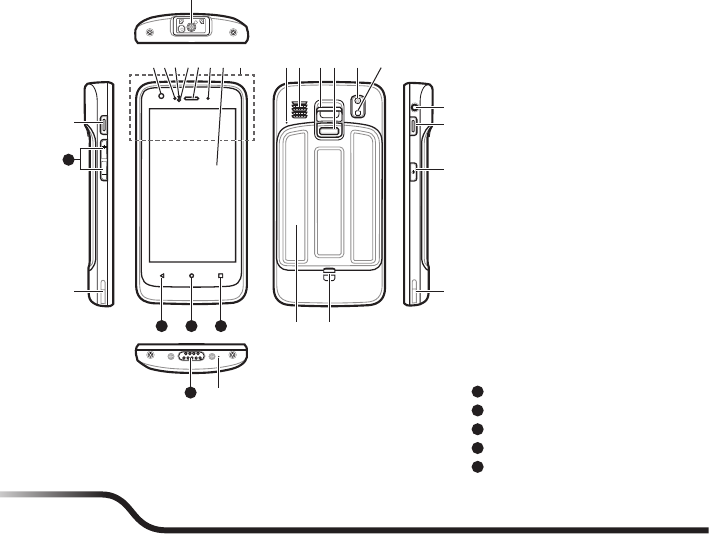
2
Your device at a glance
Note: Depending on the specic model purchased, the color and look of your device and accessories may not
exactly match the graphics shown in this document.
❶
❿⓫ ⓬⓭ ⓮ ⓯
⓰
⓱
⓲
⓳
⓬
⓴
❿
⓱
⓳
❷❸❹❺❻❼❽ ❾
212223
24
25
❶Barcode reader*
❷Front camera lens*
❸Charge indicator
❹Light sensor
❺Proximity sensor
❻Earpiece
❼Notication indicator
❽Touch screen
❾NFC sensor*
❿Microphone
⓫Speaker
⓬Lanyard holder
⓭Battery cover latch
⓮Rear camera lens*
⓯Flash*
⓰Headphone jack
⓱Barcode reader
button*
⓲Power button
⓳Socket for cradle
⓴Battery cover
21
RECENT APPS
22
HOME
23
BACK
24
Dock connector
25
Volume buttons
*For selected models only
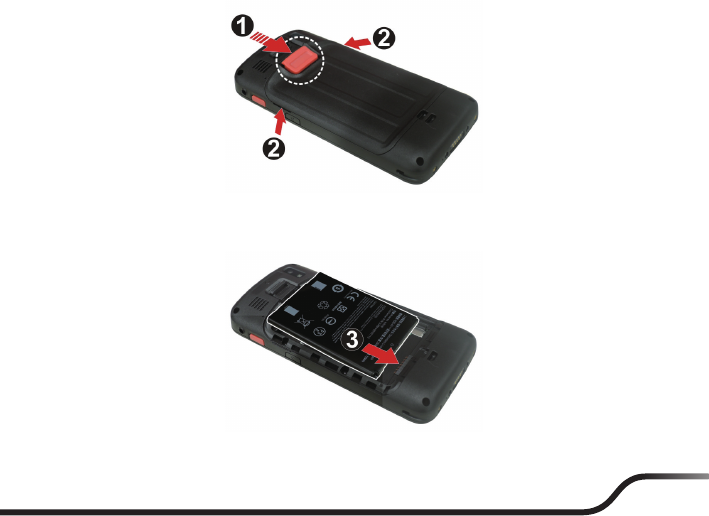
3
Installing the battery
1. Slide the battery cover latch downward to unlock the battery cover (❶).
2. Using the small opening (beside the power button) as the release point (❷),
pry the cover open along the side, and then remove the cover.
3. With the label side facing up, match the battery’s contact points, insert the
battery at an angle, and then t it into the compartment (❸).
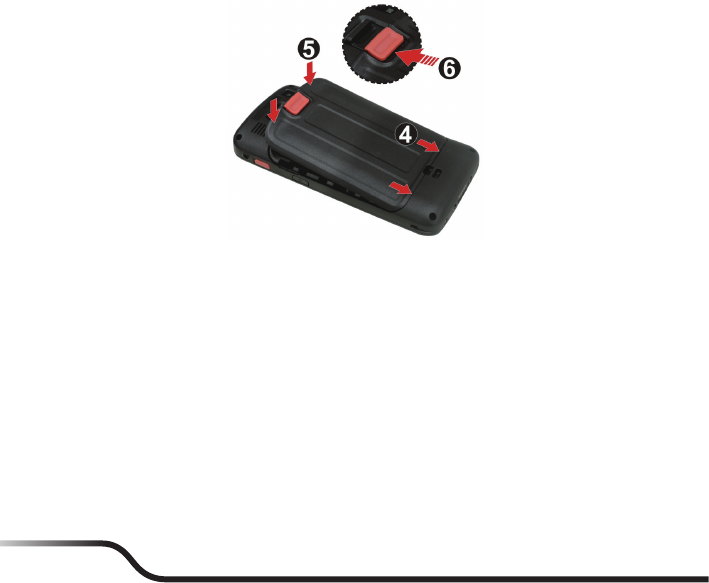
4
4. Replace the battery cover (❹), lightly press the edges of the cover (❺), and
then slide the battery cover latch upward (❻) to lock the battery cover.
Charging the battery
Note: Use only the charger supplied with your device. Use of another type of charger will result in malfunction and/
or danger.
When charging the battery for the very rst time, you should charge it for at least 8
hours (using the AC charger) with your device turned off.
1. Push the tap outwards (❶), plug the converter to the AC charger and then push
the tap inwards to lock the converter in place (❷).
2. Attach the charging cradle to the device by matching the connector on the
cradle to the dock connector on the bottom of the device (❸). Make sure that
the cradle slides into the sockets on the device properly.
3. Plug the USB end of the power cord into the AC charger (❹), and plug the AC
charger into a wall outlet (❺).
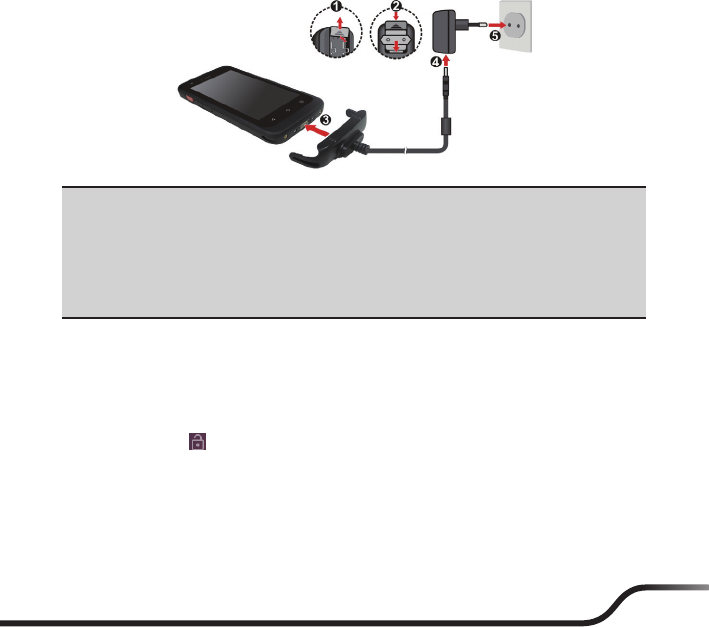
5
CAUTION: For optimal performance of the lithium battery:
yDo not charge the battery where the temperature is high (e.g. in direct sunlight).
yRecharge the battery when it is nearly discharged. When recharging, make sure that the battery is fully charged.
Doing so can extend the battery life.
yIf you will not use the product for a long period of time (over one month) or nd the discharge/recharge time has
been shortened, be sure to fully discharge the battery rst before recharging it. You are also advised to fully
discharge and recharge the battery once every 1~2 months.
yFailure to follow the battery usage instructions could cause damage to your device, battery and even bodily injury
or property damage and will void the warranty.
Turning the device ON and OFF
1. Press and hold the power button until the device turns on. Wait for the boot
screen to display.
2. The Home screen will display and the device is in Lock mode by default. Drag
the Lock icon ( ) upwards. The device is ready for use.
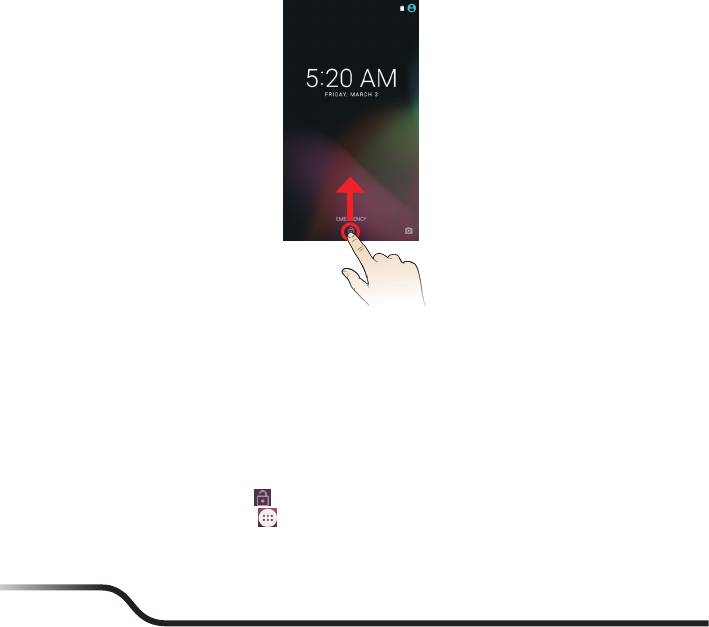
6
3. To turn off the devide, press and hold the power button for 2 seconds to display
the options menu. Then tap Power off.
Note: You can also choose to restart the device by selecting Restart from the option window.
Sleep mode
Your device will automatically switch off the screen after 1 minute (by default) of
inactivity. You can manually switch off the screen by pressing the power button
briey.
To resume the screen, press the power button briey and then unlock the device
by dragging the Lock icon ( ) upwards.
To change the settings, tap on the desktop Settings Display Sleep.
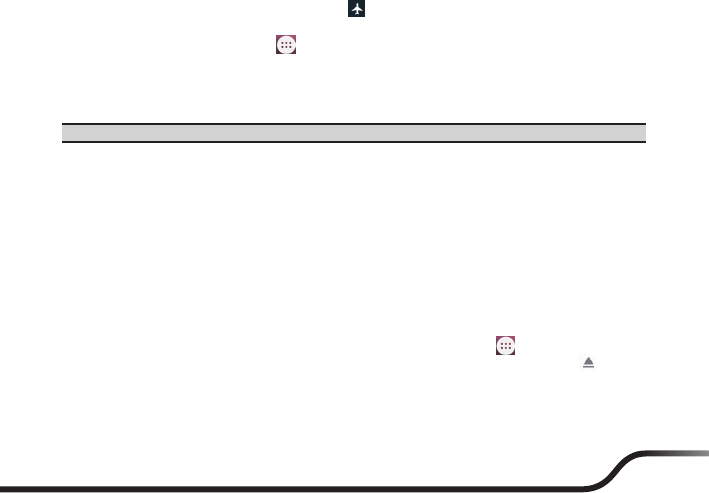
7
Airplane mode
When you are in an airplane or in the area where data transferring is not allowed,
enable Airplane mode. You will be able to use many of your device’s applications
(such as playing games or listening music), but all wireless radios, including
wireless networks and Bluetooth, on the device are turned off – it cannot send or
receive data.
To enable Airplane mode: press and hold the power button until the options menu
displays. Then tap Airplane mode. The icon in the status bar indicates that
Airplane mode is on.
To disable Airplane mode: tap on the desktop Settings More in Wirelss
& networks, and tap the Airplane mode switch to turn it off.
Installing a memory card
CAUTION: Do not apply pressure to the center of the memory card.
The memory card slot of the device is located inside the battery compartment.
1. Follow the instructions in the "Installing the battery" section to remove the
battery cover.
2. If the battery is installed, remove it.
3. Noting the card orientation, hold the card (MicroSD) by the edges and gently
insert it into the slot.
4. Replace the battery.
5. Follow the instructions in the "Installing the battery" section to replace the
battery cover.
To remove a card, rst unmount it from the device by tapping on the desktop
Settings Storage & USB. Locate the desired storage item and tap . Wait
until the card is safety unmounted. Then gently push the top edge of the card
inwards to release it, and pull it out of the slot.
Note: Inserting the card in the reverse direction may cause damage.

8
Note: The manufacturer does not guarantee the product’s compatibilities with the storage cards from all
manufacturers.
Note: If you encounter access problems with your memory card, please visit the website http://www.sdcard.org/
consumers/formatter_3/ and use the "SD Formatter 3.0 for SD/SDHC/SDXC" tool to format your memory card.
Navigating on the screen
To operate your device, touch the screen with your nger.
You can perform the following actions:
yTap: Touch the screen once with your nger to open items or select onscreen
buttons or options.
yTap and hold: Tap and hold on the desired item to open the pop-up menu
that contains the available options for the item (for example, the Copy/Move/
Rename options for a le in File Manager).
yDrag: Tap and hold on the item and then move it to the target position without
releasing your nger.
ySlide: Drag your nger vertically or horizontally across the screen.
yDrag to the left/right to switch to the next/previous item on the list.
yDrag to the top/bottom to scroll up/down the screen.
Note: Not all slide gestures are applicable to all applications.
yMulti-touch gestures: Move your ngers apart or together on the screen to
zoom in or out while viewing a picture or a web page.
Note: Not all multi-touch gestures are applicable to all applications.
yRotating the screen: For most applications, you can automatically change the
screen orientation, from portrait to landscape and vise versa, by turning the
device sideways.
Note: Rotating the screen is not applicable to all applications.
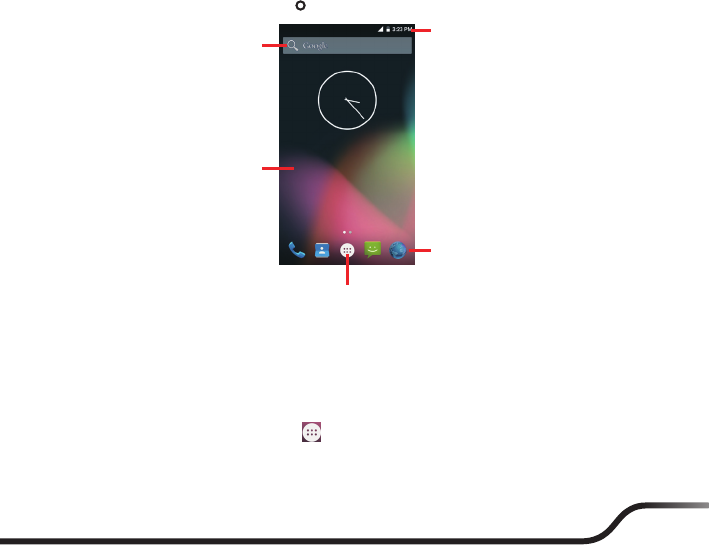
9
Home screen
The Home screen is your starting place for tasks, providing quick access to
frequently used applications and settings.
To display the Home screen, tap at any time.
Status Bar
All Apps button
Shortcuts/widgets
Desktop
Quick Launcher
Customizing your device
You can customise the device through the Settings menu, including personalizing
the Home screen, changing the display and sound settings, conguring the
connection settings, and more.
To access the Settings menu, tap on the desktop Settings.
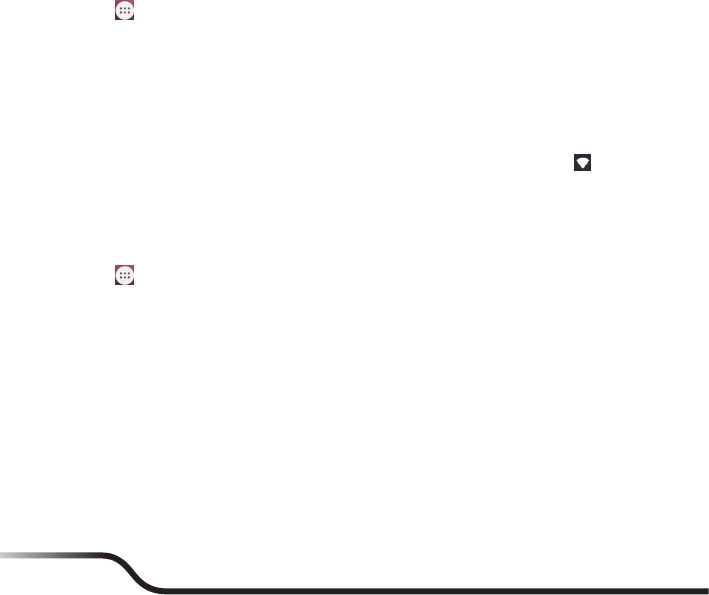
10
Wireless network connection
1. Tap on the desktop Settings Wireless & networks WLAN.
2. Tap the WLAN switch to turn it on. The device will automatically scan for
available wireless networks.
3. Tap a wireless network to connect.
4. If you select an open network, you will be automatically connected to the
network.
If you select a network that is secured with WEP, enter the key and then tap
CONNECT.
5. When your device is connected to a wireless network, the WIFI icon ( ) will
appear in the status bar indicating the signal strength (number of bands that
light up).
Bluetooth connection
To pair a Bluetooth device for sharing data:
1. Tap on the desktop Settings Wireless & networks Bluetooth.
2. Tap the Bluetooth switch to turn it on. The device will automatically scan for
available Bluetooth devices.
Note: By default, your device is not in visible mode when Bluetooth is turned on. If you need to enter visible mode: tap
Bluetooth and then tap your device name. The default visibility timeout is 2 minutes.
3. Tap a device from the list to initiate pairing.
4. On your device, the passkey is displayed. Make sure the same passkey is
displayed on the other device and then tap PAIR. Then tap PAIR on your
device to conrm pairing if necessary.
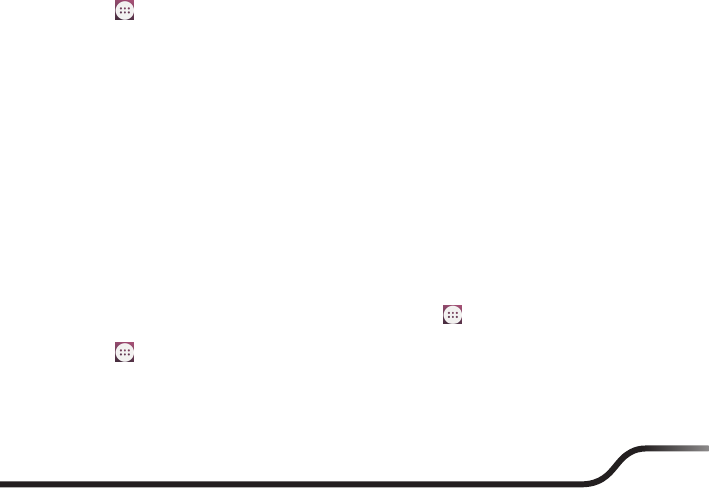
11
Using NFC
Note: This feature is not available on all models.
Your device supports the Near Field Communication (NFC) feature that allows you
to easily transfer data to an NFC-compatible device. The NFC area is located at
the upper side of the front of the device.
To turn NFC on and off:
1. Tap on the desktop Settings Wireless & networks More NFC.
2. Tap the NFC switch to turn it on or off. The device will automatically scan for
available wireless networks.
To transfer data:
1. Access the data you want to share, access the share options, and tap Android
Beam.
2. Touch the screen of your device.
3. Hold the upper front side of your device close to the NFC sensor of the other
device (within the range of 4 cm).
4. Pay attention to and accept the beam notication on the other device.
Using the barcode reader
Note: This feature is not available on all models.
By using the barcode reader, your device will be able to read the information
contained in a barcode.
1. Make sure that the barcode reader is enabled: tap on the desktop BCR
Settings, and tap the BCR Settings switch to turn it on.
2. Tap on the desktop BCR Reader.
3. Position your device close to the barcode (within the range of 5 – 10 cm), and
point the barcode reader to the barcode.

12
4. Tap the scan button on the screen or press the barcode reader button on either
side of your device to start scanning. Hold your device steadily until the scan is
complete and the information is displayed on the screen.
Caring for your device
Troubleshooting
Note: If you encounter a problem you cannot solve, contact an authorised service centre for assistance.
Power does not switch on when using battery power.
The remaining battery power may be too low to run your device. Charge the
battery.
Screen responds slowly.
Make sure that your device is not running out of battery power. If the problem still
persists, restart your device.
Screen freezes.
Restart your device.
Screen is hard to read.
Make sure that the backlight of the display is set to a high-enough brightness.
Cannot establish a connection with a computer.
yMake sure that your device and your computer are both switched on before
trying to establish a connection.
yMake sure that the cable is securely plugged into the USB port on your
computer and on your device. Connect the USB cable directly to your
computer—do not run the cable through a USB hub.
yRestart your device before connecting the cable. Always disconnect your
device before you restart your computer.

13
Caring for your device
Taking good care of your device will ensure trouble-free operation and reduce the
risk of damage to your device.
yKeep your device away from excessive moisture and extreme temperatures.
yAvoid exposing your device to direct sunlight or strong ultraviolet light for
extended periods of time.
yDo not place anything on top of your device or drop objects on your device.
yDo not drop your device or subject it to severe shock.
yDo not subject your device to sudden and severe temperature changes. This
could cause moisture condensation inside the unit, which could damage your
device. In the event of moisture condensation, allow the device to dry out
completely before use.
yThe screen surface can easily be scratched. Avoid touching it with sharp
objects. Non-adhesive generic screen protectors designed specically for use
on portable devices with LCD panels may be used to help protect the screen
from minor scratches.
yNever clean your device with it powered on. Use a soft, lint-free cloth to wipe
the screen and the exterior of your device.
yDo not use paper towels to clean the screen.
yNever attempt to disassemble, repair or make any modications to your device.
Disassembly, modication or any attempt at repair could cause damage to your
device and even bodily injury or property damage and will void any warranty.
yDo not store or carry ammable liquids, gases or explosive materials in the
same compartment as your device, its parts or accessories.
yTo discourage theft, do not leave the device and accessories in plain view in an
unattended vehicle.
yDo not expose the device to extreme heat or direct sunlight for prolonged
periods. Overheating may damage the device.

14
Regulatory information
yMarking labels located on the exterior of your device indicate the regulations
that your model complies with. Please check the marking labels on your device
and refer to the corresponding statements in this chapter. Some notices apply
to specic models only.
yFor regulatory identication purposes, the product series is assigned a model
number of N536.
yMaximum radio frequency (RF) power for Europe:
yWLAN 2.4 GHz: 20 dBm
yWLAN 5 GHz: 20 dBm
yBluetooth: 10 dBm
FCC
Federal Communication Commission Interference Statement
This equipment has been tested and found to comply with the limits for a Class B
digital device pursuant to Part 15 of the FCC Rules. These limits are designed to
provide reasonable protection against harmful interference in a residential installa-
tion. This equipment generates, uses, and can radiate radio frequency energy
and, if not installed and used in accordance with the instructions, may cause
harmful interference to radio communications. However, there is no guarantee that
interfer-ence will not occur in a particular installation. If this equipment does cause
harmful interference to radio or television reception, which can be determined
by turning the equipment off and on, the user is encouraged to try to correct the
interference by one or more of the following measures:
yReorient or relocate the receiving antenna.
yIncrease the separation between the equipment and receiver.
yConnect the equipment into an outlet on a circuit different from that to which the
receiver is connected.

15
yConsult the dealer or an experienced radio/TV technician for help.
Any changes or modications not expressly approved by the manufacturer could
void the user’s authority to operate the equipment.
This device complies with part 15 of the FCC Rules. Operation is subject to the
following two conditions: (1) This device may not cause harmful interference, and
(2) this device must accept any interference received, including interference that
may cause undesired operation.
Please note:
The use of a non-shielded interface cable with this equipment is prohibited.
IC
Canadian Department Of Communications
Radio Interference Regulations Class B Compliance Notice
This Class B digital apparatus meets all requirements of the Canada Interference-
Causing equipment regulations.
Cet appareil numérique de Classe B respecte toutes les exigences du Règlement
Canadien sur le matériel brouileur.
This device complies with Industry Canada’s licence-exempt RSSs. Operation is
subject to the following two conditions:
(1) This device may not cause interference; and
(2) This device must accept any interference, including interference that may
cause undesired operation of the device.
Le présent appareil est conforme aux CNR d'Industrie Canada applicables
aux appareils radio exempts de licence. L'exploitation est autorisée aux deux
conditions suivantes:
(1) l'appareil ne doit pas produire de brouillage, et
(2) l'utilisateur de l'appareil doit accepter tout brouillage radioélectrique subi,
même si le brouillage est susceptible d'en compromettre le fonctionnement."
The device could automatically discontinue transmission in case of absence of
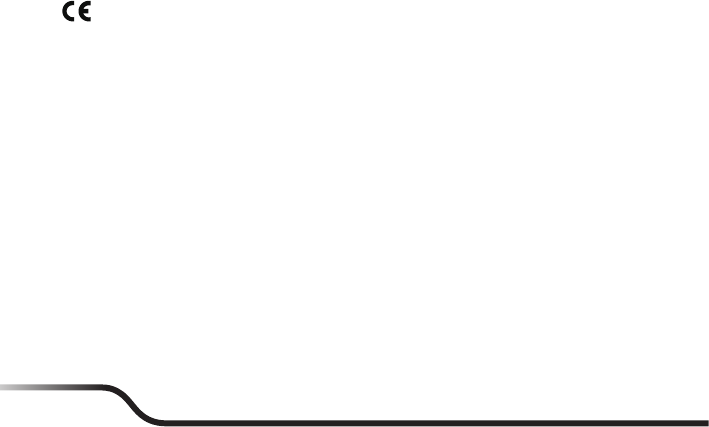
16
information to transmit, or operational failure. Note that this is not intended to
prohibit transmission of control or signaling information or the use of repetitive
codes where required by the technology.
The device for operation in the band 5150–5250 MHz is only for indoor use
to reduce the potential for harmful interference to co-channel mobile satellite
systems.
High-power radars are allocated as primary users (i.e. priority users) of the
bands 5250–5350 MHz and 5650–5850 MHz and that these radars could cause
interference and/or damage to LE-LAN devices.
CE
Products with the CE marking comply with Radio Equipment Directive (Directive
2014/53/EU) - issued by the Commission of the European Community.
Compliance with these directives implies conformity to the following European
Standards:
yEN301489-1: Electronic compatibility and Radio spectrum Matters (ERM),
ElectroMagnetic Compatibility (EMC) standard for radio equipment and
services; Part 1: Common technical requirements
yEN301489-3: Electronic compatibility and Radio spectrum Matters (ERM),
ElectroMagnetic Compatibility (EMC) standard for radio equipment and
services; Part 3: Specic conditions for Short-Range Devices (SRD) operating
on frequencies between 9 kHz and 246 GHz
yEN55032: Electromagnetic compatibility of multimedia equipment-Emission
requirements
yEN55024: Immunity characteristics
yEN6100-3-2: Limits for harmonic current emissions
yEN6100-3-3: Limitation of voltage uctuation and icker in low-voltage
yEN 300328: BT/WLAN 2.4GHz
yEN 300330: RFID/NFC
yEN301893: WLAN 5GHz
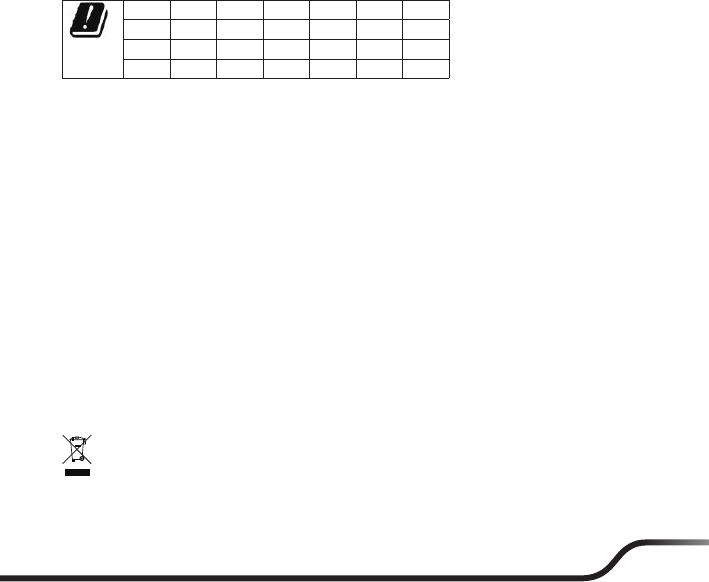
17
The device is restricted to indoor use only when operating in the 5150 to 5350
MHz frequency range.
AT BE BG HR CY CZ DK
EE FI FR DE EL HU IE
IT LV LT LU MT NL PL
PT RO SK SI ES SE UK
RF Exposure Information (SAR)
This device has been tested and meets applicable limits for Radio Frequency
(RF) exposure. Specic Absorption Rate (SAR) refers to the rate at which the
body absorbs RF energy. SAR limits are 1.6 Watts per kilogram (over a volume
containing a mass of 1 gram of tissue) in countries that follow the United States
FCC limit and 2.0 W/kg (averaged over 10 grams of tissue) in countries that
follow the Council of the European Union limit. Tests for SAR are conducted using
standard operating positions with the device transmitting at its highest certied
power level in all tested frequency bands. To reduce exposure to RF energy,
use a hands-free accessory or other similar option to keep this device away
from your head and body. Carry this device at least 10 mm away from your body
to ensure exposure levels remain at or below the as-tested levels. Choose the
belt clips, holsters, or other similar body-worn accessories which do not contain
metallic components to support operation in this manner. Cases with metal parts
may change the RF performance of the device, including its compliance with RF
exposure guidelines, in a manner that has not been tested or certied, and use
such accessories should be avoided.
WEEE
This symbol means that according to local laws and regulations your
product and/or its battery shall be disposed of separately from household
waste. When this product reaches its end of life, take it to a collection point
designated by local authorities. Proper recycling of your product will protect
human health and the environment.

18
Safety precautions
To prevent possible hearing damage, do not listen at high volume levels for
long periods.
About charging
yUse only the charger supplied with your device. Use of another type of charger
will result in malfunction and/or danger.
yThis product is intended to be supplied by a LISTED Power Unit marked with
“LPS”, “Limited Power Source” and output rated + 5 V dc / 2.0 A.
yUse a specied battery in the equipment.
About the charger
yDo not use the charger in a high moisture environment. Never touch the
charger when your hands or feet are wet.
yAllow adequate ventilation around the charger when using it to operate the
device or charge the battery. Do not cover the charger with paper or other
objects that will reduce cooling. Do not use the charger while it is inside a
carrying case.
yConnect the charger to a proper power source. The voltage requirements are
found on the product case and/or packaging.
yDo not use the charger if the cord becomes damaged.
yDo not attempt to service the unit. There are no serviceable parts inside.
Replace the unit if it is damaged or exposed to excess moisture.
About the battery
yUse a specied battery in the equipment.
yCAUTION: This unit contains a non-replaceable internal Lithium Ion battery.
The battery can burst or explode, releasing hazardous chemicals. To reduce
the risk of re or burns, do not disassemble, crush, puncture, or dispose of in
re or water.
yImportant instructions (for service personnel only)

19
yCaution: Risk of explosion if battery is replaced by an incorrect type.
Dispose of used batteries according to the instructions.
yReplace only with the same or equivalent type recommended by the
manufacturer.
yThe battery must be recycled or disposed of properly.
yUse the battery only in the specied equipment.

20
Revision: R00
(April, 2017)
Trademark
All brand and product names are trademarks or registered trademarks of their
respective companies.
Disclaimer
Specications and documents are subject to change without notice.
Note
Not all models are available in all regions.
Not all features are available on all models.
Depending on the specic model purchased, the colour and look of your device
and accessories may not exactly match the graphics shown in this document. The
screenshots and other presentations shown in this document are for reference
only.
